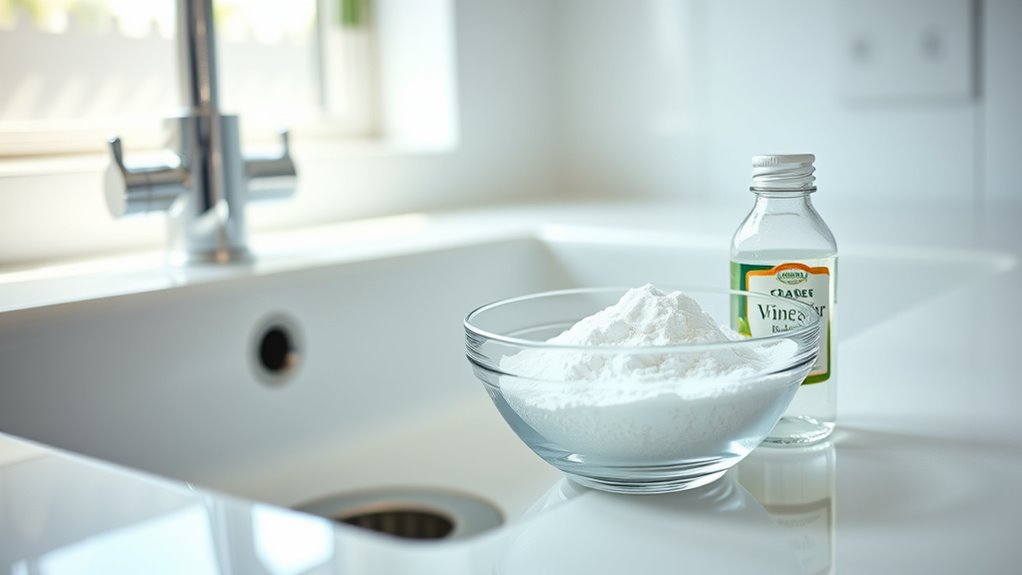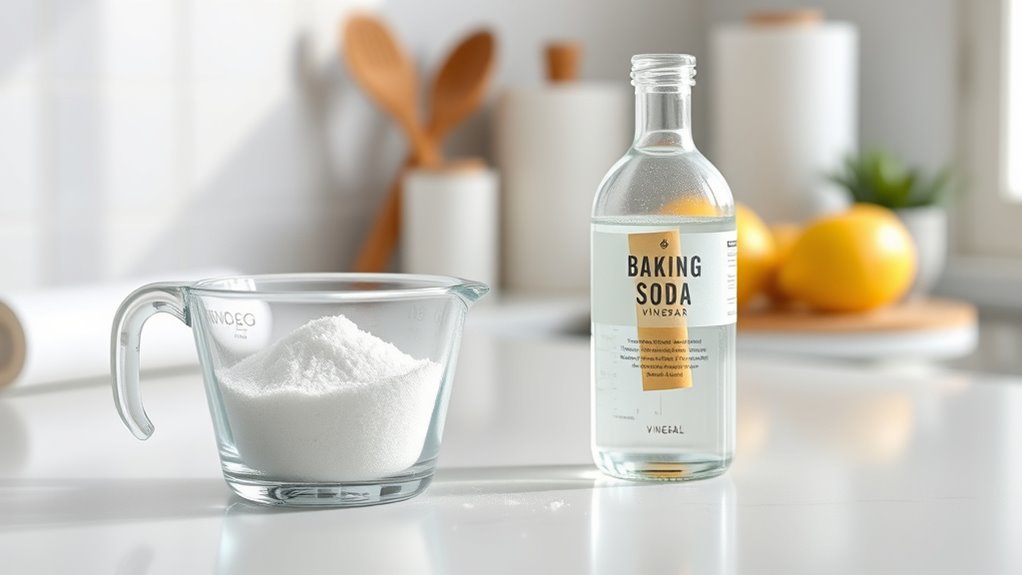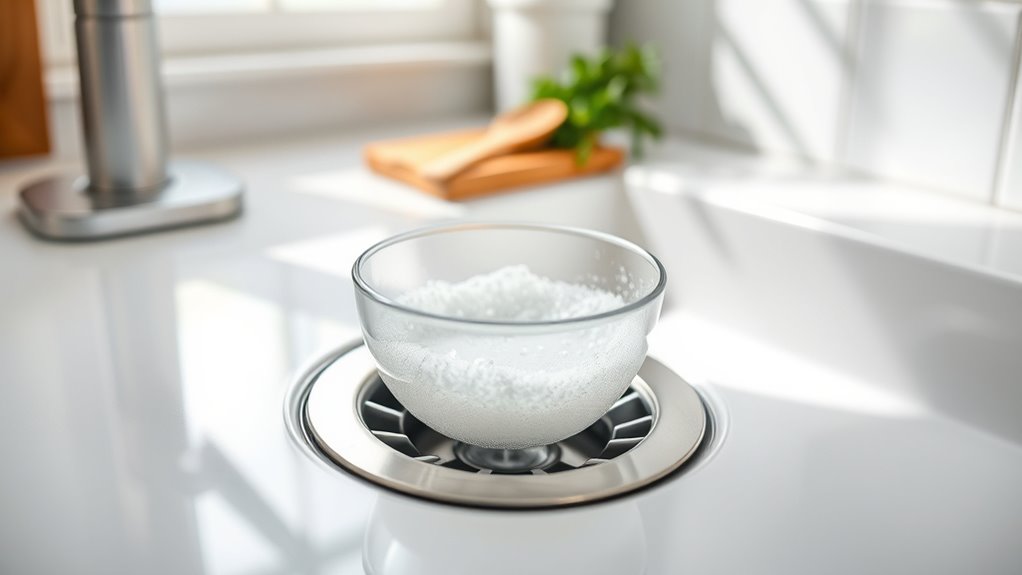To clean drain pipes with baking soda and vinegar, first remove visible debris. Pour one cup of baking soda into the drain, followed by one cup of vinegar. The bubbling reaction will help break down clogs. Let the mixture sit for 30 minutes, then flush the drain with hot water. For persistent clogs, repeat the process and consider implementing monthly maintenance to prevent future issues. More tips and detailed guidance can enhance your cleaning routine.
Understanding Clog Causes

Clogs often arise from a combination of factors that accumulate over time. Organic materials, such as hair, food particles, and grease, can build up in pipes, creating blockages.
Additionally, mineral deposits from hard water may contribute to narrowing pipe openings, making it easier for debris to become trapped. Over time, the accumulated materials harden, leading to more severe clogs that are difficult to dislodge.
Human habits also play a significant role; improper disposal of waste, such as flushing non-biodegradable items or pouring fats down the sink, exacerbates the issue.
Understanding these causes is vital for homeowners seeking to maintain their plumbing systems and prevent future clogs from developing. Awareness of these factors can lead to more effective prevention and maintenance strategies.
Benefits of Baking Soda and Vinegar
A combination of baking soda and vinegar offers numerous benefits for cleaning drain pipes. This natural duo creates a powerful reaction that helps break down clogs caused by grease, hair, and soap scum.
Baking soda acts as a mild abrasive and deodorizer, while vinegar is a natural acid that dissolves buildup. Together, they effectively neutralize odors and promote a fresher drain system.
Additionally, this method is eco-friendly, avoiding harsh chemicals that can harm plumbing and the environment. Regular use can prevent future clogs, maintaining ideal water flow.
The affordability of baking soda and vinegar makes them accessible cleaning agents for households, providing an efficient solution without the need for costly commercial products.
Ultimately, this combination is both effective and sustainable.
Safety Precautions Before Cleaning
Before initiating the cleaning process with baking soda and vinegar, it is essential to take into account several safety precautions to guarantee a smooth and safe experience.
First, ascertain proper ventilation in the area where the cleaning will occur. This helps to dissipate any odors and provides fresh air.
Additionally, wearing gloves is recommended to protect the skin from irritation, as the mixture can be caustic to sensitive skin. Eye protection is also wise, particularly if there is a chance of splashing.
Finally, avoid combining baking soda and vinegar with other chemical cleaners, as this can produce harmful reactions.
Supplies Needed for the Process
Gathering the right supplies is essential for an effective cleaning process using baking soda and vinegar. First, one needs a box of baking soda, typically available in grocery stores.
Next, a bottle of white vinegar is required, as it reacts with baking soda to break down clogs. A funnel can be useful for directing the ingredients into the drain without spills.
Additionally, having a measuring cup on hand guarantees the right proportions are used—usually about one cup of each ingredient. A boiling kettle or pot filled with water is also necessary to flush the drain after the reaction.
Finally, a scrub brush or old toothbrush can help in removing any stubborn residue around the drain opening.
Step-by-Step Guide to Cleaning Drains
To effectively clean drain pipes, one must follow a systematic approach that guarantees thoroughness and safety.
First, it is essential to remove any visible debris from the drain opening, using a pair of gloves for hygiene.
Next, pour a generous amount of baking soda directly into the drain, ensuring it reaches the deeper areas.
After a short wait, introduce vinegar into the drain, watching for bubbling action as the two substances react. This reaction helps to break down any buildup.
Allow the mixture to sit for approximately 30 minutes to maximize its effectiveness.
Finally, flush the drain with hot water to clear away remnants of the baking soda and vinegar, ensuring a clean and functional drain pipe.
Measuring the Ingredients

Proper measurement of ingredients is essential for achieving ideal results when cleaning drain pipes with baking soda and vinegar.
Accurate proportions guarantee the effectiveness of the cleaning process, maximizing the reaction between the two substances.
To measure the ingredients correctly, follow these guidelines:
- Baking Soda: Use 1 cup of baking soda for most clog situations.
- Vinegar: Measure out 1 cup of white vinegar to create a powerful reaction.
- Hot Water: Prepare 2 cups of boiling water to flush the mixture down the drain after the reaction.
- Timing: Allow the baking soda and vinegar to fizz for at least 15 minutes for best results.
Pouring Baking Soda Into the Drain
Carefully pour the measured cup of baking soda directly into the drain, guaranteeing that it reaches the deepest part of the pipe. This step is vital for effective clog removal. The baking soda will begin to work on the buildup inside the pipes, helping to break it down. It is essential to use a dry measuring cup for accuracy, as this impacts the effectiveness of the cleaning process.
| Step | Description | Outcome |
|---|---|---|
| Measure | Use a cup for precise measurement | Guarantees effectiveness |
| Pour | Directly into the drain | Targets clog buildup |
| Wait | Allow time for it to settle | Prepares for vinegar |
Following these steps will set the stage for the next phase of the cleaning process.
Adding Vinegar for a Chemical Reaction
Adding vinegar to the drain after baking soda initiates a chemical reaction that produces carbon dioxide gas.
This reaction helps to break down debris and grime within the pipes. Additionally, vinegar’s acidic properties contribute to removing stubborn buildup, enhancing the overall cleaning process.
Chemical Reaction Explained
When vinegar is introduced to baking soda in drain pipes, a vigorous chemical reaction occurs, producing carbon dioxide gas. This reaction is not only visually dramatic but also effective in breaking down clogs.
The process can be broken down into four key steps:
- Mixing: Baking soda, a base, is combined with vinegar, an acid.
- Reaction: The acid-base interaction generates carbon dioxide bubbles, creating fizzing agitation.
- Pressure Build-Up: The gas bubbles expand, increasing pressure within the pipes.
- Clog Disruption: The agitation and pressure help to dislodge debris and buildup in the drain.
This chemical reaction leverages natural ingredients to facilitate a thorough cleaning without harmful chemicals.
Benefits of Vinegar
Vinegar offers several significant benefits when used in conjunction with baking soda for drain cleaning. This common household acid enhances the effectiveness of the baking soda, creating a powerful effervescent reaction that helps dislodge clogs.
The acidity of vinegar can break down mineral deposits, grease, and organic matter, making it easier for the combined solution to clear obstructions. Additionally, vinegar serves as a natural disinfectant, eliminating odors and bacteria that may linger in the pipes.
This eco-friendly alternative minimizes the need for harsh chemicals, making it safer for both plumbing systems and the environment. Regular use of vinegar can contribute to the maintenance of clear drains, promoting long-term plumbing health without causing damage.
Covering the Drain for Maximum Effect

To achieve ideal results when using baking soda and vinegar to clean drain pipes, it is crucial to cover the drain effectively. This step enhances the reaction between the two substances and prevents them from escaping into the air.
Here are some methods for covering the drain:
- Use a damp cloth: A simple damp cloth can seal the drain while allowing pressure to build.
- Apply a drain plug: If available, a rubber drain plug can securely block the opening.
- Use a plastic wrap: Tighten plastic wrap over the drain to trap gases and enhance the cleaning process.
- Utilize a plate: Placing a flat plate over the drain can also serve as an effective cover.
Employing these techniques guarantees the maximum effect of the natural cleaning agents.
Waiting Period for Clog Dissolution
After applying the baking soda and vinegar mixture to the drain, a waiting period is essential for effective clog dissolution. This time allows the chemical reaction between the two ingredients to break down the clog. Typically, a waiting period of 30 minutes to one hour is recommended, depending on the severity of the blockage.
| Waiting Time | Effectiveness |
|---|---|
| 30 minutes | Good for minor clogs |
| 45 minutes | Effective for moderate clogs |
| 1 hour | Best for stubborn clogs |
During this time, it is advisable to avoid using the sink or drain to maximize the effectiveness of the solution. Patience is key, as allowing the mixture to work can lead to a clearer drain.
Flushing the Drain With Hot Water
Flushing the drain with hot water is an essential step following the application of the baking soda and vinegar mixture. This process helps to clear out any remaining debris and guarantees the effectiveness of the natural cleaning method.
To properly flush the drain, one should follow these steps:
- Boil Water: Heat water until it reaches a rolling boil.
- Pour Slowly: Gradually pour the hot water down the drain to prevent sudden temperature changes.
- Observe: Watch for any signs of flow improvement, indicating that the clog is breaking down.
- Repeat if Necessary: If necessary, repeat this process for better results, guaranteeing the drain is completely clear.
This simple yet effective method can help maintain a clean and functional drain system.
Repeat Process for Stubborn Clogs
For stubborn clogs that resist initial attempts at clearing, repeating the process with baking soda and vinegar can yield better results. This method relies on the chemical reaction between the two substances, which helps to break down debris more effectively. To enhance the process, the following table outlines the recommended steps and timing for maximum efficiency:
| Step | Action | Timing |
|---|---|---|
| 1. Pour Baking Soda | Add 1 cup into the drain | Immediate |
| 2. Add Vinegar | Follow with 1 cup | 5 minutes |
| 3. Wait | Allow reaction to occur | 15-30 minutes |
| 4. Flush | Rinse with hot water | 1 minute |
| 5. Repeat if necessary | Assess and repeat | As needed |
Reassessing and repeating can ultimately lead to a clearer drain.
Additional Tips for Maintenance
To maintain peak drain performance, establishing a regular cleaning schedule is essential.
Additionally, avoiding the buildup of grease and debris can greatly reduce the likelihood of clogs.
Implementing these practices will contribute to a cleaner and more efficient plumbing system.
Regular Drain Cleaning Schedule
Establishing a regular drain cleaning schedule is crucial for maintaining ideal plumbing health and preventing clogs. By implementing a consistent routine, homeowners can greatly reduce the likelihood of blockages and associated plumbing issues.
Here are some effective tips for a successful schedule:
- Monthly Maintenance: Clean drains with a baking soda and vinegar solution once a month to dissolve buildup.
- Seasonal Checks: Inspect and clean drains seasonally to prevent debris accumulation from changing weather conditions.
- Post-Event Cleaning: After hosting gatherings or large cooking events, promptly clean drains to address potential clogs from food particles.
- Professional Inspections: Consider scheduling a professional drain cleaning service annually to guarantee thorough maintenance and address potential issues.
Avoid Grease and Debris
A consistent effort to avoid grease and debris is essential for maintaining clear drain pipes. Homeowners should implement practices that minimize the accumulation of these substances.
For instance, disposing of cooking oils and fats in designated containers rather than pouring them down the sink can greatly reduce grease buildup. Additionally, using sink strainers can effectively capture food particles and debris before they enter the plumbing system. Regularly cleaning these strainers will further enhance drain performance.
It is also advisable to educate household members about proper disposal techniques, ensuring that non-biodegradable items, such as wipes and plastics, are not flushed.
Alternative Natural Cleaning Solutions
Exploring alternative natural cleaning solutions can provide effective methods for maintaining drainage systems without harsh chemicals.
These solutions are not only environmentally friendly but also safe for household use. Here are four effective options:
- Salt: A natural abrasive that can help break down residues and eliminate odors.
- Lemon Juice: Its acidity can help dissolve grease and provide a fresh scent.
- Borax: A powerful mineral that works as a disinfectant and can help eliminate buildup in pipes.
- Tea Tree Oil: Known for its antibacterial properties, it can combat mold and other microbial growth in drains.
These alternatives can be used regularly to keep drains clear and functioning efficiently.
When to Call a Professional
When faced with persistent clogs that resist home remedies, it may be time to seek professional assistance.
Complex plumbing problems can require specialized knowledge and tools that an average homeowner may not possess.
Recognizing the signs that indicate the need for expert help can save time and prevent further damage.
Persistent Clogs Issues
How can homeowners determine if a persistent clog requires professional intervention? Various indicators suggest that a clog may be beyond DIY solutions. Recognizing these signs can save time and prevent further damage.
- Frequent Recurrences: If clogs happen repeatedly despite regular maintenance, it may indicate a deeper issue.
- Multiple Drains Affected: When more than one drain is slow or clogged, it could signal a systemic problem in the plumbing.
- Unpleasant Odors: Foul smells emanating from drains often indicate decomposing material, requiring professional assessment.
- Water Backups: If water backs up into other fixtures, immediate professional help is essential to avoid extensive damage.
Addressing these signs promptly can lead to more effective solutions and maintain plumbing health.
Complex Plumbing Problems
Identifying complex plumbing problems can be intimidating for homeowners. These issues often manifest as persistent leaks, sewage backups, or extensive water damage, indicating underlying complications that may exceed DIY solutions.
When symptoms persist despite basic remedies, such as baking soda and vinegar treatments, it suggests a deeper issue, potentially involving damaged pipes, improper installations, or tree root intrusions.
Homeowners should also be cautious of symptoms like low water pressure or unusual noises from fixtures, as these may signal serious concerns. In such cases, it is prudent to call a professional plumber.
Expert plumbers possess the necessary tools and experience to diagnose and resolve complex plumbing issues effectively, ensuring the home remains safe and functional without risking further damage.
Conclusion
In a serendipitous moment, as the bubbling reaction of baking soda and vinegar danced within the drain, the once stubborn blockage surrendered, releasing a sigh of relief. The kitchen, once filled with frustration, now echoed with the sweet sound of flowing water. With each swirl, the pipes gleamed anew, reminding homeowners of the power of natural solutions. This simple, yet transformative process not only cleared the clogs but also instilled a newfound appreciation for the harmony of nature in everyday life.

I’m Allen Kim, the chief editor of plumbinginto. I am a mid level plumber and assign to an local firm over 4 years of experience. During the working period, most of my experience is related to the house plumbing. I learned about the thing, when working with most experienced people in this sector, one must be as good as the inspector or better with knowledge of the project as well as the practical aspects of plumbing industry.